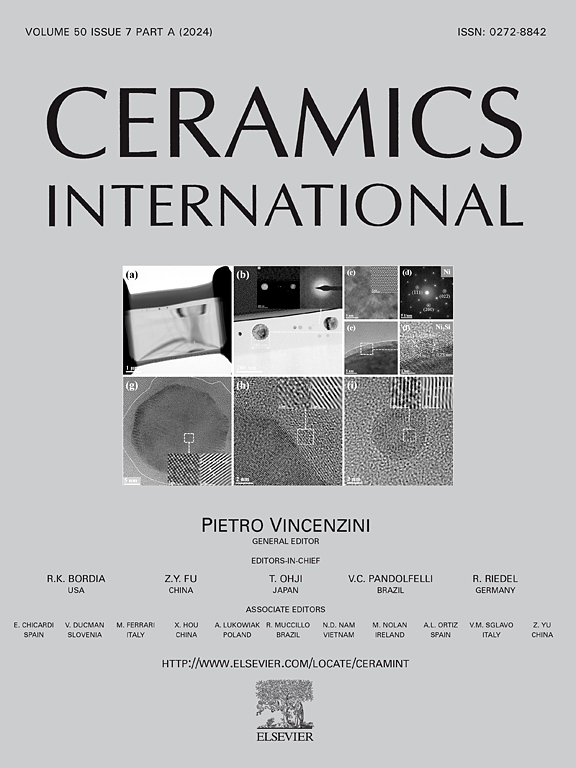Enhancing photocatalytic potential of Mg0.5Ti0.5Fe2O4.5 NPs by optimizing the sintering temperature
IF 5.1
2区 材料科学
Q1 MATERIALS SCIENCE, CERAMICS
引用次数: 0
Abstract
Ti4+substituted magnesium ferrite nanoparticles (Mg0.5Ti0.5Fe2O4.5) with spinel structure were synthesized using the sol-gel process and sintered at 300, 400 and 500 °C. Mg0.5Ti0.5Fe2O4.5 nanoparticles were studied using X-ray diffraction (XRD), X-ray photoelectron spectroscopy (XPS), Fourier transform infrared spectroscopy (FT-IR), Scanning Electron Microscopy (SEM) with X-ray dispersive spectroscopy (EDS), High Resolution Transmission Electron Microscopy (HRTEM) and Selected Area Electron Diffraction (SAED). Surface area of all synthesized nanoparticles was compared using BET method. The effect of sintering temperature on structure and photocatalytic activity was examined using tetracycline hydrochloride as a model pollutant under visible light irradiation. The XRD patterns confirmed the presence of spinel structure in Mg0.5Ti0.5Fe2O4.5NPs at all heat-treated temperatures and in the pure phase. TEM and SEM-EDX analyses confirmed the porosity and agglomeration in the doped ferrite nanoparticles. Infrared spectra showed absorption bands between 400 and 600 cm−1, confirming the presence of the ferrite phase. Lattice constant and band gap energy were decreased due to substitution of tetravalent Ti4+ ion. Mg0.5Ti0.5Fe2O4.5 sintered at 400 °C showed a minimal band gap of 2.10 eV and highest photocatalytic potential. The combination of hydrogen peroxide and ferrites was discovered to have a synergistic effect on the photodegradation of tetracycline hydrochloride. Quenching experiments demonstrated that hydroxyl radicals and holes were dominating in the degradation of tetracycline hydrochloride under visible light. Kinetic studies of photodegradation and quenching tests were carried out using the Langmuir-Hinshelwood model.
求助全文
约1分钟内获得全文
求助全文
来源期刊

Ceramics International
工程技术-材料科学:硅酸盐
CiteScore
9.40
自引率
15.40%
发文量
4558
审稿时长
25 days
期刊介绍:
Ceramics International covers the science of advanced ceramic materials. The journal encourages contributions that demonstrate how an understanding of the basic chemical and physical phenomena may direct materials design and stimulate ideas for new or improved processing techniques, in order to obtain materials with desired structural features and properties.
Ceramics International covers oxide and non-oxide ceramics, functional glasses, glass ceramics, amorphous inorganic non-metallic materials (and their combinations with metal and organic materials), in the form of particulates, dense or porous bodies, thin/thick films and laminated, graded and composite structures. Process related topics such as ceramic-ceramic joints or joining ceramics with dissimilar materials, as well as surface finishing and conditioning are also covered. Besides traditional processing techniques, manufacturing routes of interest include innovative procedures benefiting from externally applied stresses, electromagnetic fields and energetic beams, as well as top-down and self-assembly nanotechnology approaches. In addition, the journal welcomes submissions on bio-inspired and bio-enabled materials designs, experimentally validated multi scale modelling and simulation for materials design, and the use of the most advanced chemical and physical characterization techniques of structure, properties and behaviour.
Technologically relevant low-dimensional systems are a particular focus of Ceramics International. These include 0, 1 and 2-D nanomaterials (also covering CNTs, graphene and related materials, and diamond-like carbons), their nanocomposites, as well as nano-hybrids and hierarchical multifunctional nanostructures that might integrate molecular, biological and electronic components.
 求助内容:
求助内容: 应助结果提醒方式:
应助结果提醒方式:


